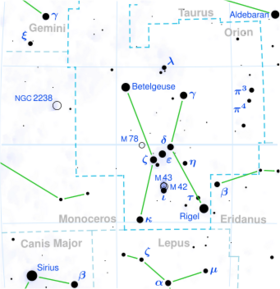Astronomy:Xi Orionis
| Observation data Equinox J2000.0]] (ICRS) | |
|---|---|
| Constellation | Orion |
| Right ascension | 06h 11m 56.39693s[1] |
| Declination | +14° 12′ 31.5555″[1] |
| Apparent magnitude (V) | 4.47[2] |
| Characteristics | |
| Spectral type | B3 IV[3] |
| U−B color index | −0.65[2] |
| B−V color index | −0.19[2] |
| Astrometry | |
| Radial velocity (Rv) | +19.30[4] km/s |
| Proper motion (μ) | RA: +0.29[1] mas/yr Dec.: −20.12[1] mas/yr |
| Parallax (π) | 5.37 ± 0.23[1] mas |
| Distance | 610 ± 30 ly (186 ± 8 pc) |
| Orbit[5] | |
| Period (P) | 45.1 d |
| Eccentricity (e) | 0.26 |
| Periastron epoch (T) | 2,441,962.3 JD |
| Argument of periastron (ω) (secondary) | 205° |
| Semi-amplitude (K1) (primary) | 22.4 km/s |
| Details | |
| ξ Ori A | |
| Mass | 6.7±0.1[3] M☉ |
| Luminosity | 1,390[6] L☉ |
| Temperature | 15,476[6] K |
| Rotational velocity (v sin i) | 160[7] km/s |
| Age | 32.1±4.3[3] Myr |
| Other designations | |
| Database references | |
| SIMBAD | data |
Xi Orionis (ξ Orionis) is a binary star system in the northeastern part of the constellation of Orion, well above the red giant star Betelgeuse in the sky. It lies next to another blue main-sequence star, Nu Orionis, which is somewhat closer at 520 light-years' distance. The apparent visual magnitude of Xi Orionis is 4.47,[2] which is bright enough to be seen with the naked eye. The distance to this star, as determined using the parallax method, is roughly 610 light-years.[1]
This is a spectroscopic binary star system with an orbital period of 45.1 days and an eccentricity of 0.26.[5] The primary component is a B-type subgiant star with a stellar classification of B3 IV.[3] With an estimated age of just 32 million years,[3] it has a relatively high rate of spin, showing a projected rotational velocity of 160 km/s.[7] Xi Orionis has about 6.7 times the mass of the Sun,[3] and shines with 1,390 times the solar luminosity from its outer atmosphere at an effective temperature of 15,476 K.[6]
References
- ↑ 1.0 1.1 1.2 1.3 1.4 1.5 van Leeuwen, F. (2007), "Validation of the new Hipparcos reduction", Astronomy and Astrophysics 474 (2): 653–664, doi:10.1051/0004-6361:20078357, Bibcode: 2007A&A...474..653V.
- ↑ 2.0 2.1 2.2 2.3 Crawford, D. L. et al. (1971), "Four-color, H-beta, and UBV photometry for bright B-type stars in the northern hemisphere", The Astronomical Journal 76: 1058, doi:10.1086/111220, Bibcode: 1971AJ.....76.1058C.
- ↑ 3.0 3.1 3.2 3.3 3.4 3.5 Tetzlaff, N. et al. (January 2011), "A catalogue of young runaway Hipparcos stars within 3 kpc from the Sun", Monthly Notices of the Royal Astronomical Society 410 (1): 190–200, doi:10.1111/j.1365-2966.2010.17434.x, Bibcode: 2011MNRAS.410..190T.
- ↑ de Bruijne, J. H. J.; Eilers, A.-C. (October 2012), "Radial velocities for the HIPPARCOS-Gaia Hundred-Thousand-Proper-Motion project", Astronomy & Astrophysics 546: 14, doi:10.1051/0004-6361/201219219, A61, Bibcode: 2012A&A...546A..61D.
- ↑ 5.0 5.1 Pourbaix, D. et al. (2004), "SB9: The ninth catalogue of spectroscopic binary orbits", Astronomy and Astrophysics 424 (2): 727–732, doi:10.1051/0004-6361:20041213, Bibcode: 2004A&A...424..727P.
- ↑ 6.0 6.1 6.2 McDonald, I. et al. (2012), "Fundamental Parameters and Infrared Excesses of Hipparcos Stars", Monthly Notices of the Royal Astronomical Society 427 (1): 343–57, doi:10.1111/j.1365-2966.2012.21873.x, Bibcode: 2012MNRAS.427..343M.
- ↑ 7.0 7.1 Abt, Helmut A.; Levato, Hugo; Grosso, Monica (July 2002), "Rotational Velocities of B Stars", The Astrophysical Journal 573 (1): 359–365, doi:10.1086/340590, Bibcode: 2002ApJ...573..359A.
- ↑ "ksi Ori". SIMBAD. Centre de données astronomiques de Strasbourg. http://simbad.u-strasbg.fr/simbad/sim-basic?Ident=ksi+Ori.
 |


